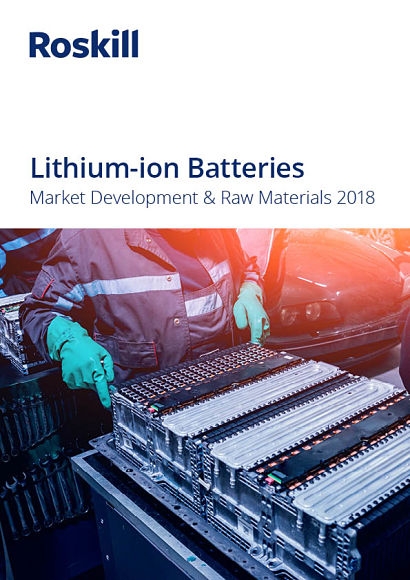
The transition from a market dominated by portable electronics to a market led by lithium-ion batteries in xEVs and ESS has seen the requirements for larger batteries with greater battery capacity, longevity and reliability. These changing battery requirements have catalysed the production and use of higher nickel-cathode chemistries such as NCA, NCM 532 and NCM 622.
In its report ‘Lithium-ion Batteries Market Development & Raw Materials 2018’, Roskill uses its inhouse automotive model to evaluate the changing demands of lithium-ion batteries, including demands for battery components, raw material requirements, and the possible impact of new technologies such as solid-state batteries on the overall demand for battery raw materials.
The strong demand growth forecast for lithium-ion batteries requires many individual components to be produced in order to manufacture a lithium-ion battery cell. These include cathodes, anodes, separators, electrolyte salts and solutions, copper and aluminium foils, binders and cell cases, all of which require a wide array of materials and industrial expertise. The supply chain and production processes for these materials are complex and long, involving multiples stages, with over 150 established companies producing the 9 key components required for the final battery cell product.
The focus of the lithium-ion battery supply chain has been solidly centred in the Asian market, with over 87 percent of lithium-ion battery cell producers profiled located in Asia, though several producers plan to construct new manufacturing facilities in Europe and the USA. These expansions will ultimately adjust to evolving demand, especially from the automotive industry. Nevertheless, while many market analyses only consider plug-in EVs, other types of electric vehicles such low speed EVs (LSEV) and mild hybrids (48V) must be also considered to obtain a better demand perspective.
Regulatory changes across all regions have accelerated the development and uptake of xEVs, with emissions standards, subsidies and incentives; and potential bans on the sale of combustion vehicles influencing automaker investments, future models and consumer choice. The on-going trend is considered irreversible, as OEMs and component manufacturers have invested heavily in production infrastructure and research and development capabilities for xEVs. Transportation and energy sectors will need to become cleaner, and lithium-ion batteries are currently the most suitable instrument to achieve that end.
In 2018, China remained the largest market for xEVs, with sales surpassing 1.0M units for the first time. China has supported the production and sales of xEVs in its domestic market through a series of subsidies and incentives, resulting in both cash or non-cash benefits. These subsidies were changed in January 2019 to reduce the benefits applied to lower range xEVs, impacting vehicles with ranges under 200km. As manufacturers now look to target vehicles with longer ranges to still qualify for subsidies, the requirements of lithium-ion batteries and the demand for the raw materials used in their manufacture is ever-changing.
The demand for raw materials used in lithium-ion batteries is expected to increase exponentially, as a result of both sales volumes and changing requirements for battery components. Lithium demand from lithium-ion batteries is forecast to grow by 26 percent per year in the years to 2028, increasing from 136.7kt lithium carbonate equivalent (LCE) to in excess of 1.4Mt LCE. Demand for nickel and cobalt will also experience considerable demand growth albeit their feedstock availability may be compromised. Beyond feedstock, the previous minerals and other relatively abundant materials as graphite and copper will face challenges, especially in the conversion capacity to process them into battery-grade materials.
For additional information:
Roskill market report - ‘Lithium-ion Batteries Market Development & Raw Materials 2018’

